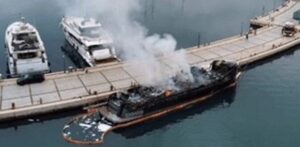
IIMS CEO, Mike Schwarz, has been alarmed at what seems to be a growing number of destructive yacht and boat fires incidents reaching his desk since the start of 2025. Mike has been motivated to write this article so he can set out and catalogue some of the higher profile fire incidents, as well as some of the less well publicised ones.
This is an expanded article following the introduction I wrote for the IIMS June News Bulletin on this subject. It may have passed you by, but there seems to have been a string of eye-catching large yacht and boat fires erupting around the world since the start of 2025 with devastating consequences. So, what is behind this surge in yacht and boat fires? Is there a common thread? Not sure yet, is the simple answer.
So, what we do know is that boat fires are nothing new. I have no idea who records the number of yacht and boat fires across the world from one year to the next – someone must – but it seems to me that 2025 has been an appalling year so far, although how it compares in reality with previous years, I cannot be sure. Remarkably the death toll has been low, but the instances of catastrophic fires have become too frequent. And of even greater concern, are the fires affecting tour and dive boats.
In some cases, we must wait for the results of ensuing investigations. Some causes, tragically, will never be known. And what about the impact for insurers in what is already a tight market? How often can they keep paying out sometimes extraordinary sums of money?
Whilst the reason of a boat fire is not always known instantly, lithium-ion batteries are said to have been the cause of one devastating fire in Marseille in January which kick started this unwelcome run of boat fires.
This fire destroyed Naisca IV and spread to two nearby yachts. The second yacht was also destroyed, while the third sustained severe damage to her port side. Dubtless there was damage to the marina infrastructure too. Oil booms were deployed to mitigate the environmental harm. Who knows what the final cost to insurers will be, once the dust settles.
Also in January, a 29-metre Princess Yacht was destroyed in a blazing inferno. The vessel was allegedly being chartered by the renowned hip-hop producer Metro Boomin, who was not on board at the time. The Miami-Dade Fire Department mobilised more than 30 units, including ground crews and rescue boats, to contain the growing fire. However, the yacht eventually took on too much water and capsized into the river.

Three further major fires occurred during March. The 29.63-metre Azimut motor yacht Ramonda was destroyed in the Portonovi resort marina in Montenegro. The images are horrific and very little remains of the vessel – just a charred and burnt- out hulk from what I can see. The local police force managed crowd control and supported the operation, whilst firefighter units worked to extinguish the fire. However, according to reports, the fire could not be contained on site.
That same month, three yachts were destroyed following a marina fire in northwest Miami-Dade County, Florida, on the Miami River. According to local reports, authorities arrived at the scene to discover all three yachts ablaze. Firefighting efforts ensued from both shore and sea, with the fire extinguished three hours later by “foam techniques”. Two of the affected vessels were below 24 metres, with the other confirmed to be the 30.8-metre Rodman yacht Nirvana.
The other fire to catch my attention involved a Colombian catamaran tour boat. The incident forced 89 tourists to abandon ship. The Daily Mail reported that “all 92 passengers and crew in the Caribbean Sea off the city of Santa Marta in northern Colombia were forced to abandon ship after their vessel caught fire”. An initial investigation revealed that the blaze on the tour boat Katamaran Tayrona I ignited after one of its engines suffered an electrical short. Taximarino, operator of Katamaran Tayrona I, has since issued a statement, which is of little comfort, saying that the engines fitted on the vessel were rebuilt approximately two months prior to the incident. Does that make it OK? Of course not!
Moving on to April, a massive fire erupted on a yacht in Fethiye’s Karagozler Marina in Türkiye. Firefighting teams from Fethiye and Seydikemer initially responded but were unable to contain the flames. Arriving swiftly at the marina, emergency crews worked intensively to control the fire, but it seems they could not prevent it from spreading to other nearby boats. Actual facts about the incident are sketchy. Eyewitnesses stated that one of the burning yachts had recently been launched and was a relatively new vessel.
And then bizarrely by coincidence in April, two dive-boat engine fires occurred on successive days in southern Thailand. All passengers and crew involved were able to be rescued.
In the second incident, 18 tourists and Thai passengers and 8 crew had to take to a life-raft in the Andaman Sea in the early hours. The vessel, the 35m steel DiveRACE Class E, had brought divers to Khao Lak National Park, and anchored for the night ready to visit the 1980s wreck of the tin-mining dredger Boonsung and surrounding coral reef the next day.
Just the previous day, fire had broken out in the stern of a smaller commercial boat, the Aor Subpiti, as its engine burst into flames. Sixteen- year-old helmsman Manawat Bialy sustained significant burns to his arms and face when the engine exploded close to where he had been working, but he was still said to gone on to help get the family safely into the water before trying to put out the fire.

These two incidents happened less than a month after 26-year-old London backpacker Alexandra Clarke went missing when the charter dive-boat David John caught fire and sank. Clarke had been one of 22 tourists and crew on the vessel when the fire broke out some 10km off the coast of Ko Tao on the western side of the Gulf of Thailand.
According to police the boat’s fuel tank overflowed while being refilled, with the vapour ignited by a spark when the engine was started. Fire spread quickly through the engine-room, as the divers and crew jumped into the sea. They were rescued by the crews of private boats alerted by an emergency call. The vessel eventually sank and the captain and the crewmember who had been filling the tank have been charged with negligence.
More problems for Egyptian maritime authorities
Egypt’s liveaboard industry received another blow with the news that the Emperor Seven Seas had been burned out by a fire while docked in Port Ghalib marina. Thankfully, no crew or passengers were injured, and while the vessel was declared a total loss, everyone was safely evacuated as the fire took hold and could not be dealt with.
A statement from Emperor said: ‘In the early hours of Thursday, 13 March, Emperor Seven Seas was moored in Port Ghalib when a fire broke out that could unfortunately not be contained.
On the other side of the world, two separate boat fires in New York and New Jersey on the same night killed 2 women, with a further 3 hospitalised.
The newspaper report said, “Raging fires engulfed boats in New Jersey and Westchester in separate incidents overnight that saw two people dead and three hospitalised, according to officials. The two females were taken to University Hospital, where they were pronounced dead.” Bet that story passed you by?
Then just four hours later, a larger blaze broke out at Imperial Yacht Club, a marina on the Isle of San Souci in New Rochelle. A total of seven boats were destroyed as it took firefighters two hours to get the blaze under control.
There have been other serious yacht fires too in recent months. What I have shared with you is the tip of the iceberg. So, what are we to make of this situation, which seems to be setting a rather worrying trend? The intensity and severity of these fires are also of concern. It is remarkable that more people were not killed.
Once again, these cases highlight the continuing spate of fires affecting the boating and tour boat industries. While it could certainly be argued that these fires are disproportionately reported due to the sensational and excessive use social media, the rate of total losses caused by such incidents would seem to be increasing. Until the industry identifies and addresses the root causes of yacht and tour boat fires, it seems inevitable that such incidents will likely persist and only grow in volume and severity.
